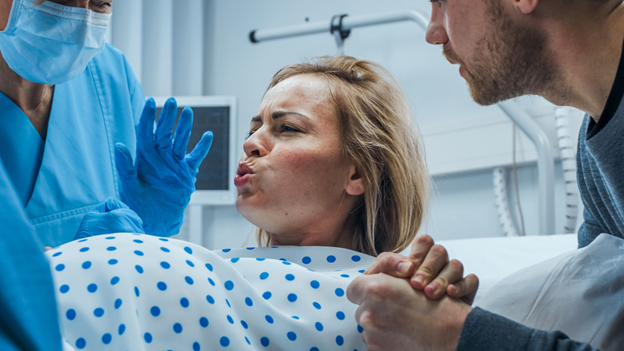
What Are The Stages of Labor?
Every woman’s body is different, and so each woman will have a different experience when in labor. If you plan to get pregnant or are pregnant now, it’s important to understand the stages of labor and birth so that you can be as prepared as possible.
The First Stage – Early or Latent Labor
The first stage of labor is typically the longest; it is the period where your cervix starts to dilate, or open. The latent phase can begin several weeks before labor, and it may be accompanied by no symptoms whatsoever.
As your cervix opens, however, you may begin to feel contractions. They may be only mildly noticeable at first, occurring only every 5 to 20 minutes. When contractions become moderate, they will likely intensify and last for longer periods of between 30 and 45 seconds.
You can know that early labor has begun when your contractions occur several minutes apart but become closer as time passes. Other signs that you’re in early labor are:
- Indigestion
- Menstrual-like cramping, or labor pains
- Mucous discharge with a bloody tinge (called bloody show)
- Diarrhea
- Backache that occurs steadily or only with each contraction
- Pressure in the lower abdomen
- Warmth in the abdomen
Although it typically occurs in the latest stage of labor, your water can break during the latent phase.
Suggestions for the First Stage
Once you’ve confirmed you’re in early labor, it’s important to ensure you do all you can to care for yourself. Get as much sleep as you can during this stage, as, once you enter later stages, your contractions will be too intense to allow for uninterrupted rest.
Keeping yourself busy is also recommended during this stage. Walking can accelerate the labor process. That being said, it’s a good idea to walk close to home. Always ensure you have your phone with you so that you can contact your birth partner or emergency services if you need to.
Eating toast, bananas, or other light and healthy snacks recommended by your health practitioner will help to give you the energy you’ll need for the later stages of labor. Water is absolutely essential in the latent phase, and you’ll want to ensure you urinate as much as possible to ensure your labor progresses smoothly.
Call your hospital or birthing center if:
- Your water has broken and has a green color
- You don’t feel any fetal movement
- You suspect you’ve had more than two tablespoons of discharge
- Your discharge has become bright red in color
The Second Stage – Active Labor

During active labor, your cervix is fully dilated and you will deliver your baby. This process can take several hours and is also the time when your health practitioner will be there to assist you, either at home, at the birthing center, or in the hospital.
The active phase of labor is characterized by more intense contractions that are longer and more frequent than what you experienced in the first stage. Generally, contractions during active labor last between 40 and 60 seconds, occur three to four minutes apart, and may be so intense they prevent you from speaking.
During this stage, you can expect to experience increasing pain and more intense contractions, along with:
- Heaviness or discomfort in the legs
- Water breaking either naturally or artificially, depending on individual circumstances
- Increased discharge
- More intense backache
- Fatigue
- A feeling of pressure in the abdomen
If you’ve chosen to have an epidural, you may experience little to no pain and discomfort at this stage. However, it’s important to talk to your doctor ahead of time about what to expect with an epidural and how pain is managed once the epidural is placed.
Another part of the active labor stage is called transition, as it is the point when your cervix dilates from 8 centimeters to the fully dilated 10 centimeters. At this point, you will feel intense contractions that last from 60 to 90 seconds, and you will feel the urge to push.
Suggestions for the Second Stage
During the second stage, there will be fewer opportunities for resting. Your emotions may also be more erratic, which is a very common experience. The second stage is when you’ll become fully immersed in pushing and delivering your baby, and your comfort becomes a top priority. As such, it’s important to do the following:
If breathing exercises are in your plan, this is the time to start them. If they don’t help that’s okay, too; do whatever else you find relaxing or what makes you feel as comfortable as possible.
Staying hydrated is just as important in this phase; your birthing partner or nurse should be offering you ice chips, water, and other clear and light beverages at this time. Light snacks like popsicles may also be offered if you are hungry.
Do what you can to relax during delivery, as this will help you conserve energy. Focused breathing, positive visualization, and other techniques can all help.
Ensure you urinate regularly; the pressure on your pelvis can mask a full bladder, which can interfere with labor. If you haven’t had an epidural, keep moving if you can by changing your position or walking a bit.
Finally, don’t hesitate to ask for help from your birthing partner or healthcare practitioner. They are there to help you be as comfortable as you can be.
The Third Stage – Placenta Delivery

Following the delivery of your baby, the next stage is the delivery of the placenta. This stage typically lasts between 5 and 30 minutes but can last up to one hour. During the third stage, the placenta will detach from your uterine wall and exit through your vagina. Some women deliver the placenta naturally while others may require uterine massage for delivery.
During this stage, you can expect to experience:
- Chills
- Trembling
- Light contractions
The final stage is also the time when you get to form the first physical connection with your baby. Your baby will be placed on your bare chest, for skin-to-skin contact (also known as kangaroo care), and covered with a blanket to keep them warm. If you’ve chosen to do so, you can also begin breastfeeding at this time.
Aftercare
Following the delivery of your baby, your uterus will contract and become firm enough for you to feel it around your navel. This is both normal and necessary, as uterine contraction helps close the open blood vessels left following detachment of your placenta to stop bleeding.
Your doctor may also prescribe you pain medication to manage pain or stop any residual bleeding. At the aftercare stage, your contractions will become progressively milder. Some women who have had a baby before may have mild contractions for the next one or two days.
Your doctor may also repair any tears that occurred during childbirth and will examine your placenta to confirm it was delivered in its entirety. Most importantly, this is the time to finally get some pain relief and enjoy being with your baby. Congratulations!
Leaders in Women’s Health
Whether you’re currently pregnant or considering having a baby, the OB/GYN providers at Crystal Run Healthcare offer a full range of care at every stage of pregnancy, from preconception counseling to postpartum care, including after the birth of your baby.
At Crystal Run, you’ll benefit from a highly qualified team of healthcare specialists that includes board-certified obstetricians and gynecologists, as well as the latest scanning, imaging, and surgical technologies. Together, they form a comprehensive solution that commits itself to the health of mother and baby. Learn more by visiting us online or calling 845-703-6999.

 Optum Radiology at Crystal Run Healthcare
Optum Radiology at Crystal Run Healthcare Request medical records online
Request medical records online